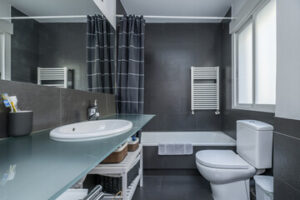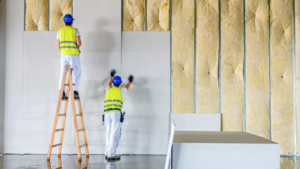Bathroom remodeling adds value to your home, improves comfort and functionality and may increase safety for elderly or disabled family members. Mistakes can be costly and even dangerous, so it’s important to do your homework.

Labor and materials vary widely depending on where you live, so shopping around is key. Be sure to include a contingency fund in your budget for unexpected problems. Contact Bathroom Remodeling Lexington KY for professional help.
Bathroom remodeling is a big commitment in terms of design. Most of the selections are “hard” finishes that can’t be easily changed out, so it’s important to get it right from the start. The style, materials and colors chosen will have a significant impact on the overall look of your bathroom. Choosing the right color scheme, lighting and accessories can make your remodel last longer and look better than ever.
Layered lighting is one of the most important elements to consider. This can help to create a warm and welcoming atmosphere, as well as minimizing shadows around vanity areas. A clever light fixture like a chandelier can also add an instant touch of luxury to your bathroom.
Flowing and coordinating tile is another key aspect of bathroom design. It can make the space feel larger and more open, especially when a darker tile is used for the floor and lighter for the walls. Matching vanities, mirrors and sconces can further elevate the look of your bathroom.
Freestanding tubs are a stunning focal point and a luxurious addition to any bathroom. Choose from antique claw-foot designs or contemporary modern styles to suit your bathroom. If you are adding a freestanding tub, opt for a curbless entry to minimize plumbing costs.
Walk-in showers are an increasingly popular choice for bathroom renovations. They provide a sleek and modern look, while still providing the convenience of a traditional shower. Curbless entries are more cost-effective than traditional doors, and they will also keep your remodel on budget.
Bathrooms are damp and steamy environments, so it’s important to have adequate ventilation. A simple fan will help to minimize condensation, reducing the risk of mold and rot. You can also add a window vac to quickly suck up moisture that may linger on the frames.
Before beginning any remodel, it is crucial to establish a budget and timeline with your contractor. This will help to prevent unforeseen expenses and ensure the project stays on track. Choosing the right fixtures and materials will also be critical to your budget. Using online tools to estimate costs can help to ensure that you are staying within your limits.
Materials
One of the most important parts of a bathroom remodel is deciding on what materials will go into the project. The type of material you use will impact the cost of your project, but also the overall look and functionality of the space. It’s important to choose stylish and functional materials that will stand up to the elements.
For example, a shower wall requires water-resistant materials to prevent mold and mildew. Using drywall may not be a good option, as it is vulnerable to moisture damage and must be properly sealed with Redgard or another waterproofing membrane. Instead, a framed shower wall made of cement board is a much better choice for long-term durability.
Flooring is another area where it’s important to use water-resistant materials. Vinyl, natural stone tile and hardwoods are great choices for traction and moisture-resistance. Cork is also a great option, as it’s an environmentally friendly alternative to hardwood.
The same considerations apply to your walls and cabinets, which should be made of a durable material that’s easy to clean. Plywood, solid wood and medium-density fiberboard are all excellent options. Avoid particleboard, which is vulnerable to moisture and can lead to rot.
Painting is a simple way to give your bathroom a fresh new look, but it’s important to use paint that’s moisture-resistant. A semi-gloss finish is ideal and will help protect against mold and mildew.
Using the right materials in your bathroom can add a sense of luxury and increase your home’s value. This is especially true for high-end materials like marble or quartz that will appeal to a wide range of buyers.
When planning your bathroom remodeling, it’s important to work with a full-service contractor that can offer both design and build services. This will save you time and money by allowing you to streamline the process. Additionally, a contractor can ensure that your plans are feasible and will meet local building codes. They will also be able to help you find the best deals on your materials and make sure that everything is in place before beginning construction.
Budget
When it comes to bathroom remodeling, your imagination is likely running wild. The good news is that you can probably create a spa-like retreat even on a tight budget. The key is to focus on what you need versus what you want, and be honest about your priorities. You may have to sacrifice some luxuries, but it’s important to find the balance between your needs and your dreams.
Choosing your materials can make or break your remodel budget. Basic options like ceramic tiles cost $2 to $10 per square foot, while patterned or marble options can double or even triple those figures. Other cost-influencing factors include sinks, toilets, shower and tubs.
In general, plumbing and electrical upgrades account for 30-50% of total project costs, while materials and labor represent the rest. In addition, if your renovation involves expanding the footprint or changing the layout of your space, you’ll need to factor in additional construction expenses and permit fees.
It’s also a good idea to consider the time of year when you’ll be conducting your renovation. Contractors are busier in the summer and around holidays, so they’ll typically charge premium rates. You can usually save money by renovating in the winter.
Before you start spending, it’s essential to determine your goals for the remodel and prioritize them. Is your bathroom in need of a simple cosmetic update, or do you require more extensive structural changes?
A complete gut and remodel is a major undertaking that often involves tearing down walls, revamping plumbing systems and installing new flooring and tiles. These projects are best left to professional contractors, as they’re familiar with local regulations and permitting requirements.
If you’re looking for a way to spruce up your bathroom without taking on a full-scale renovation, consider replacing cabinet hardware and mirrors, upgrading the light fixtures or painting the room a fresh color. These updates can make a big difference in the overall look and feel of your bathroom, and they won’t add as much to your budget as a freestanding tub or smart toilet.
Installation
Before starting a renovation, it’s important to determine which components and fixtures you plan to keep and which ones you want to replace. This helps you stay within your budget and timeline, as well as avoid costly revisions and unforeseen expenses. It also allows you to decide whether you will take on some of the labor yourself or hire professional contractors. If you’re planning to do any DIY tasks, be sure to prepare by gathering materials and researching the task ahead of time. If you’re working with a contractor, make sure they have the necessary tools and safety equipment for the job.
Choosing the right materials and fixtures for your bathroom can help you achieve your aesthetic goals and boost your home’s resale value. However, it’s also important to consider your lifestyle and functionality needs when making these decisions. For example, if you have elderly family members or young children, you may need to install safety features like grab bars, hands-free faucets, slip-resistant surfaces, or a wider doorway. If you have limited storage, adding cabinets or shelving may be a necessity.
Surface updates: Paint, tile, and flooring are cosmetic changes that can refresh a room’s look and feel. This type of remodel is less expensive than a complete overhaul but can still make a significant impact on the overall appearance.
Mid-level renovations: These upgrades go beyond surface updates and include installing new countertops, replacing a tub, or upgrading the sink and vanity. They’re generally more expensive than surface level remodeling, but offer better functionality and premium finishes.
Gut renovation: This type of transformative project requires ripping out walls, rerouting plumbing lines, and changing electrical wiring. It can be more expensive than other types of remodeling, but it’s a great way to change up the layout and improve functionality.
Before beginning any work on your bathroom, be sure to check with local authorities about building and electrical permits. Failure to obtain the proper permits can result in hefty fines or even work stoppages. Having the necessary permits can also save you money in the long run by ensuring that your remodel complies with current codes.
